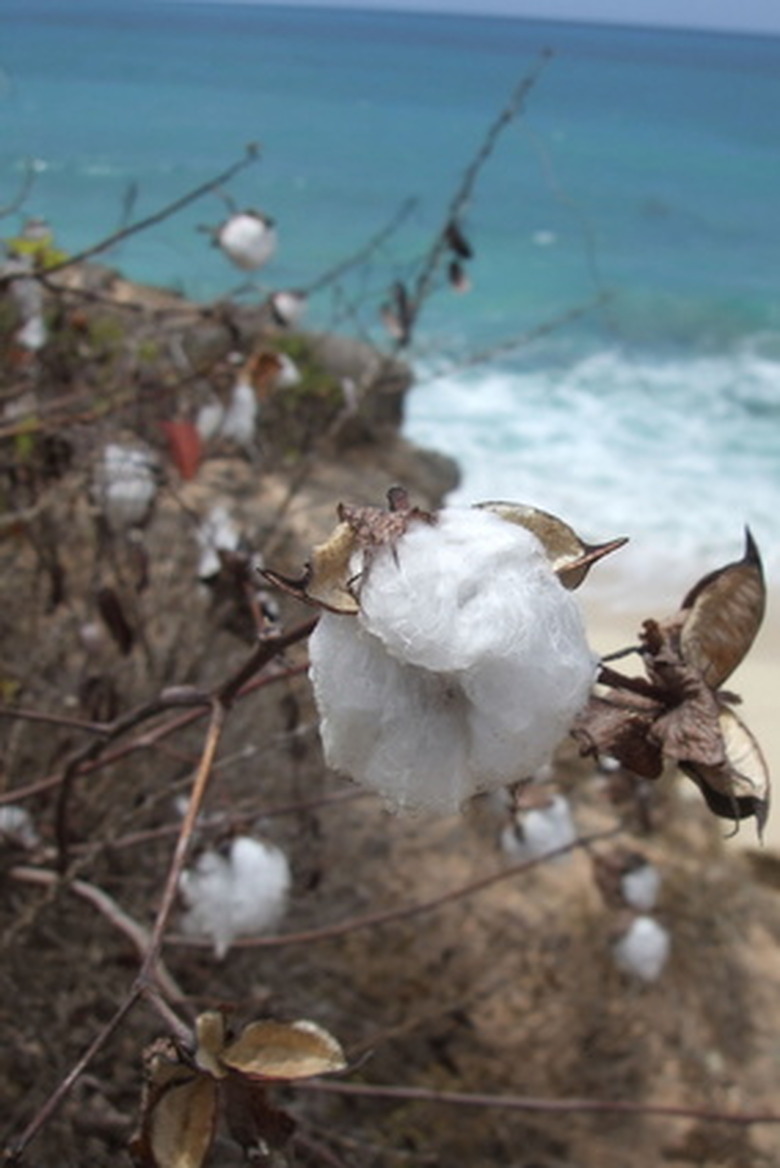Definition Of Cotton Seed Pod
The U.S. is the third largest grower of cotton in the world. Cotton seeds are believed to have been cultivated in Florida in 1556, but the actual age of cotton growing is unknown. Cotton cloth has been found in Mexico that is 7,000 years old. The Industrial Revolution and the invention of the cotton gin, a machine that separates the waste (seeds, sticks, dead leaves, etc.) from the cotton, have been credited for the huge rise in cotton production. The crop was an important economic footprint in the New World and paved the way for other agricultural mass crops.
Planting
Most commercial planting is done by machine. Sowing is done over previous season debris in the "no-till" method, or the land is plowed and then mechanically planted. Seedlings can emerge four to five days after planting if soils are warm and average 60 degrees Fahrenheit. The plant begins the process of forming its basic organs: roots, stems, leaves and fruits. Fruits are comprised of squares, flowers and bolls or seed pods.
- The U.S. is the third largest grower of cotton in the world.
- The Industrial Revolution and the invention of the cotton gin, a machine that separates the waste (seeds, sticks, dead leaves, etc.)
Squares
Squares are part of the flower on a cotton plant. They generally appear five to eight weeks after planting. The square will become a bud in three weeks and then emerges as a flower. June and July are the biggest months for squares to form and they usually start on the lowest branch of the plant and work upward. The square starts out the size of a pinhead and develops in just a few short weeks to a bud. It is imperative to cotton production that there be many squares in succession on the plants.
Buds and Flowers
The cotton buds don't last long. The buds turn into pretty, little white flowers about 23 days on average after the square forms. Flowers on one fruiting branch take eight days to open after another branch has flowered. This is called vertical flowering. The flowers start out white and turn pink in 24 hours.
- Squares are part of the flower on a cotton plant.
- The square will become a bud in three weeks and then emerges as a flower.
The flowers have both male and female parts and can self fertilize. The fertilized flower will shed in a week and reveal a boll, also called the cotton seed pod. The fertilized parts are ovules and will become seeds. Cotton fiber grows from special cells embedded in the pod and lengthen. They are filled in by cellulose until the outside of the pod is dry and pops open.
Bolls or Seed Pods
Inside the boll there are 20 to 30 seeds and the white fibers that characterize cotton. The amount of fibers will be consistent with the amount of water the plant received while it was in flower. More water equals more fibers, so irrigation intensifies at flowering time.
- The flowers have both male and female parts and can self fertilize.
- The fertilized flower will shed in a week and reveal a boll, also called the cotton seed pod.
The boll reaches full size in 24 days, but needs another 24 to 40 days to fill in with cellulose. The boll dries up and cracks open, indicating it is ready to harvest. The fibers and seeds are separated and the seed is used for cottonseed oil and animal feed. The fibers require more cleaning before they can go into production.
Harvesting
Separating the seeds and the fibers as well as any twigs or other debris is the job of the cotton gin. Gin is just short for "engine" and is a mechanical means of cleaning the cotton. First it needs to be picked and a stripper or spindle picker does this mechanically. The cotton is dried out and ginned. Then the seeds go to a factory where the cotton is baled. The bales are stored until it is time to process them.
- The boll reaches full size in 24 days, but needs another 24 to 40 days to fill in with cellulose.
- The fibers and seeds are separated and the seed is used for cottonseed oil and animal feed.
